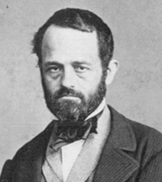Annibale de Gasparis

Annibale de Gasparis (November 9, 1819, Bugnara[1] –March 21, 1892, Naples; Italian pronunciation: [anˈniːbale de ˈɡasparis]) was an Italian astronomer, born in Bugnara to parents originally from Tocco da Casauria.
From 1864 to 1889 he was the director of the Astronomical Observatory of Capodimonte in Naples.[2] His name was occasionally written Annibal de Gasparis, including by himself.[3]
He won the Gold Medal of the Royal Astronomical Society in 1851. Awarded the Lalande Prize in 1851 and 1852.
The main-belt asteroid 4279 De Gasparis as well as the 30-kilometer lunar crater de Gasparis and the nearby 93-kilometer long fracture Rimae de Gasparis, are named in his honour.[2]
Discoveries
Annibale de Gasparis discovered visually the following 9 asteroids. In addition, he also independently discovered 14 Irene, which discovery was however credited to the English astronomer John Russell Hind.[2][4]
| 10 Hygiea | April 12, 1849 |
| 11 Parthenope | May 11, 1850 |
| 13 Egeria | November 2, 1850 |
| 15 Eunomia | July 29, 1851 |
| 16 Psyche | March 17, 1852 |
| 20 Massalia | September 19, 1852 |
| 24 Themis | April 5, 1853 |
| 63 Ausonia | February 10, 1861 |
| 83 Beatrix | April 26, 1865 |
References
- ↑ Hockey, Thomas (2009). The Biographical Encyclopedia of Astronomers. Springer Publishing. ISBN 978-0-387-31022-0. Retrieved August 22, 2012.
- 1 2 3 Schmadel, Lutz D. (2007). Dictionary of Minor Planet Names – (4279) De Gasparis. Springer Berlin Heidelberg. p. 367. ISBN 978-3-540-00238-3. Retrieved 16 June 2016.
- ↑ Letter from de Gasparis to Benjamin Valz announcing the discovery of 10 Hygiea in 1849
- ↑ "14 Irene". Minor Planet Center. Retrieved 16 June 2016.
- ↑ "Minor Planet Discoverers (by number)". Minor Planet Center. 23 May 2016. Retrieved 16 June 2016.
- Various (2009). The Observatory - A Monthly Review of Astronomy 1892. pp. 231–232. ISBN 978-1-4446-6672-4.
- Longo, Giuseppe. "Annibale de Gasparis" (PDF). Archived from the original (PDF) on 2010-03-07.